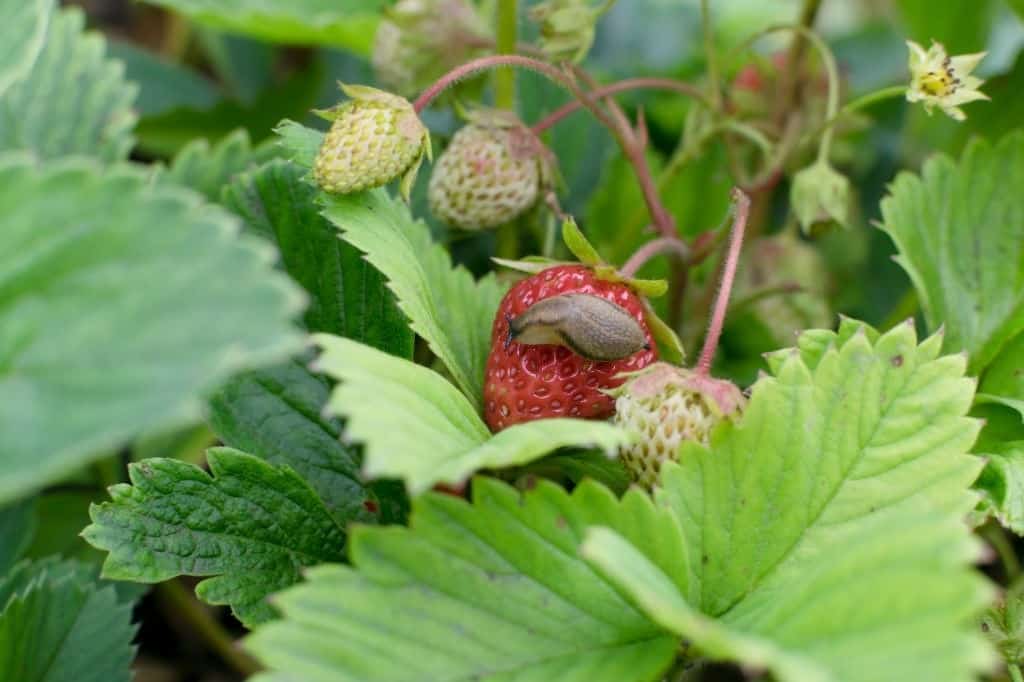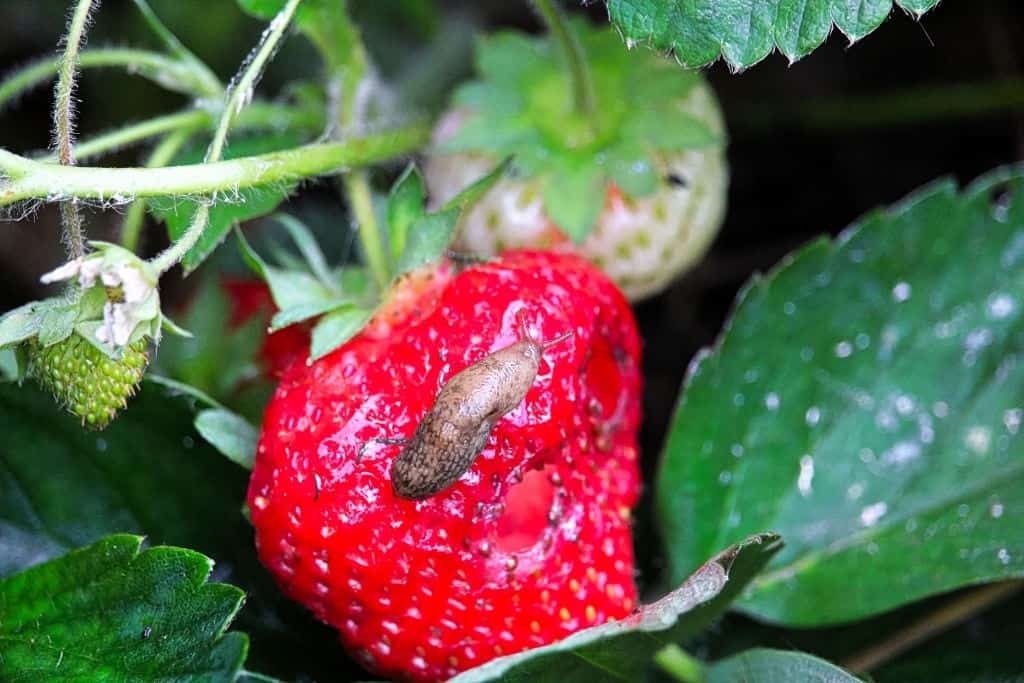Have you been wanting to know how to keep slugs off strawberry plants organically?
These pests can easily ruin your crops, causing you hours of work.
But you need to be cautious about the method you use for slug removal. It is always better to stick to a chemical-free way of preventing these invaders in your garden. After all, the last thing you want is to ingest harmful chemicals that will impact your health.
Stick around and learn more about these quick and easy tips you can do to prevent slug infestation in your strawberry patch once and for all. And yes, these are organic, safe, and effective methods that anyone can do!

Learn How to Keep Slugs Off Strawberry Plants Organically
It is not a big surprise to most people to see slugs in their garden.
These garden pests are your land-mollusks – critters that are notorious for chewing up leaves, leaving tracks of slime, and eating up seedlings.
If you have a strawberry patch in your garden, the last thing you would want is to have these slugs pester your crops. You need to be sure that you get them out before they cause devastating damages to your precious strawberries.
Some gardeners resort to using chemicals to eliminate these pests. However, this is not always the safest route to take.
Afterall, slug baits filled with chemicals can kill these critters, yet they can also harm your health. Any questionable substance you put on your crops can negatively impact your body once ingested.
Thus, organic slug removal techniques are still best when dealing with these pests in your garden.
How to Keep Slugs Off Strawberry Plants Organically
Nobody wants a slug hanging around their crops. In addition to that ick factor, they are the bane of gardeners as a few species feed on your plants.
If you have strawberries growing in your garden, you would want to do all you can to shield your crops from these invaders. Otherwise, you will not be sinking your teeth into these juicy berries anytime soon.
This is why it is best to learn how to keep slugs off strawberry plants organically. Not only is it the safe way to put an end to these pests but it also works effectively without producing adverse effects.

Here are some things you can do to eliminate slug infestation in your precious garden.
1. Diagnose the problem.
First things first – you need to diagnose correctly the cause of the problem.
Keep in mind that slugs feed at night. This is why you wake up the next day witnessing the damage and searching aimlessly for the culprit.
Many gardeners assume that any insecticide can exterminate the garden invader. However, it does not always work that way. In fact, these general insecticides cannot do anything to kill or prevent slugs from coming back.
The traditional way is to simply pick them out. Yet, it is not something many people are keen on doing because it is not only disgusting but quite challenging, too. Considering their feeding time, which is at night time, you will have to stick around and wait until they arrive to pick them out.
2. Inspect the damage.
This step is closely linked to the first one. You need to inspect carefully the damage to really be certain that a slug is behind it.
The common signs of slug damage include:
- Perfectly round holes in strawberry fruits and leaves
- Slime rails on rocks and plants
- Completely destroyed seedlings with just the stumps left
- Leaf centers and edges bearing ragged holes
If you see these tell-tale signs of slug damage in your crops, it’s time to move on to the next step:
3. Perform traditional practices.
Now that you are certain it’s a slug (or slugs) causing harm to your crops, you can then begin to take action.
A way to prevent these critters from invading is by making some tweaks to your water schedule. Always remember that slugs prefer wet conditions. This is why you should consider watering in the early morning. Thus, your soil does not stay damp and will not attract slugs to camp out.
Additionally, you can put some “anti-slug” plants such as those with fuzzy or fragranced foliage. Slugs dislike these, which will discourage them from going to your crops.
Clear loose mulches that are a favorite spot of slugs. Instead of using hay or straw mulches, go for leaf mold or compost.
4. Use slug traps.
A good old trap always works against slugs. At dusk, simply lay a few 2×4’s in between your crops. Flip them over the following afternoon to collect the buggers. In fact, you can even use watermelon rinds (inverted) and place them throughout your strawberry patch.
5. Encourage predators in the garden.
Believe it or not, some animals are actually beneficial in killing slugs.
Good animals to have in your garden include toads, lizards, and snakes. These predators can easily eliminate your slug problems quickly and organically.
6. Beat slugs with copper.
Did you know that copper is harmful to slugs?
Slug slime and metal copper don’t mix as this creates an electric shock. If you have a smaller garden, you can simply use copper tape and cover some plants with a ring of this material. This should work perfectly fine.
If you have raised beds, however, you can staple copper tape on the edges to shield your crops from these slimy invaders.
Here are a few more tips you can try on how to keep slugs off strawberry plants organically. Check this video out to learn more.
Bottom Line
It is not fun seeing your strawberry plants in a nasty mess due to slug infestation.
Fortunately, there is a way to solve this problem without using hazardous chemicals. With these 6 simple steps on how to keep slugs off strawberry plants organically, you can protect your crops from these invaders and ensure their growth without impacting your health and the environment.
Can I use salt and my strawberry garden
Hi friend,
Yes, salt can be used in your strawberry garden, but it should be used with caution and in moderation. Salt can be beneficial for strawberries when used in small amounts and under specific circumstances.
One way salt can be helpful is by controlling weeds in your garden. Sprinkling a small amount of salt around the base of the strawberry plants can help prevent weed growth. However, it’s essential to be careful not to oversaturate the soil with salt, as excessive amounts can damage the plants.
Another possible use of salt is for pest control. Some pests, such as slugs and snails, can be deterred by creating a barrier of salt around the plants. However, keep in mind that salt can also harm beneficial insects and soil organisms, so it’s crucial to use it sparingly and only when necessary.
It’s important to note that strawberries prefer slightly acidic soil conditions, and salt can increase the salinity of the soil, potentially causing harm to the plants. Therefore, it’s best to perform a soil test before adding salt to your garden and ensure that the soil pH and nutrient levels are suitable for strawberry growth.
In general, it’s advisable to use organic and natural methods to maintain a healthy strawberry garden. Regular watering, mulching, proper fertilization, and pest management techniques like companion planting are often more effective and safer for your plants and the environment. If you have concerns about your strawberry garden or are facing specific challenges, it’s a good idea to consult with local gardening experts or extension services for tailored advice.
Have a nice day!